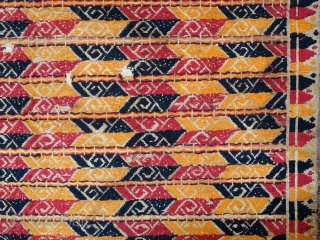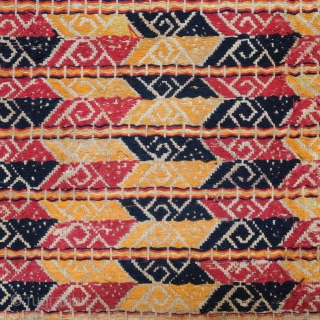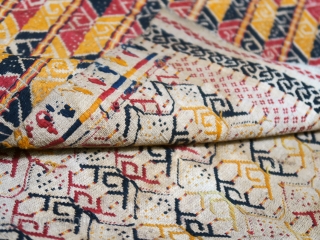Back
Indonesia | Antique ceremonial weaving tampan
Indonesia, Sumatra, Lampung, c. 1900
Handspun cotton base, supplementary weft weaving, botanical dyes, gold-wrapped thread
a large, festive tampan with a colourful geometric design of interlocking parallelograms in saffron yellow, deep indigo blue and true red, woven in supplementary silk weft over an undyed cotton base. Although the coloured threads cover the base in alternating blocks, the base exposed so as to as to form hooked lines within each unit. Framing every two rows are meandering lines in red, yellow and gold-wrapped threads that visually organize the two rows into bi-coloured chevrons reminiscent of the ships in the ship-cloths to which this piece belongs. At the sides, a row of triangles in the same colours echoes the centrefield design. Triple borders above and below in red band dotted with white flowers, a row of floral indigo motifs and a zigzag line add to the formality of the piece.
Context: Tampan, like the larger palepai, use supplementary weft as a decorative technique, where the practical need to secure the yarn to the foundation at intervals in large motifs is met by patterning the motif with intricate ribbing, cross-hatching and dotting; thus the limitations of the technique define the style and beauty of the genre (m. Gittinger, ‘South Sumatran Ship Cloths’, repr. 2010, 9). Tampan means ‘tray’; it is used as a tray cloth, a cover for ceremonial food offerings, a seat for the primary participants in a ritual and a variety of symbolic functions: a baby is laid on a tampan when introduced to its maternal grandparents, while the father’s family brings gifts wrapped in tampan. It is wrapped around its male counterpart—the metal sword or lance—carried in marriage procession, and is an essential part of a bride’s dowry, where it could number in the hundreds (r. Maxwell, Sari to Sarong, 5).
The textile is in good condition for its age. There are three patched repairs and small breaks to the threads here and there. The gold-wrapped thread is quite worn, but retains a light glimmer, and the colours are all vibrant and intense. The cotton is fairly light but robust, with a sandy hand.
w 70 cm x l 67 cm
Indonesia, Sumatra, Lampung, c. 1900
Handspun cotton base, supplementary weft weaving, botanical dyes, gold-wrapped thread
a large, festive tampan with a colourful geometric design of interlocking parallelograms in saffron yellow, deep indigo blue and true red, woven in supplementary silk weft over an undyed cotton base. Although the coloured threads cover the base in alternating blocks, the base exposed so as to as to form hooked lines within each unit. Framing every two rows are meandering lines in red, yellow and gold-wrapped threads that visually organize the two rows into bi-coloured chevrons reminiscent of the ships in the ship-cloths to which this piece belongs. At the sides, a row of triangles in the same colours echoes the centrefield design. Triple borders above and below in red band dotted with white flowers, a row of floral indigo motifs and a zigzag line add to the formality of the piece.
Context: Tampan, like the larger palepai, use supplementary weft as a decorative technique, where the practical need to secure the yarn to the foundation at intervals in large motifs is met by patterning the motif with intricate ribbing, cross-hatching and dotting; thus the limitations of the technique define the style and beauty of the genre (m. Gittinger, ‘South Sumatran Ship Cloths’, repr. 2010, 9). Tampan means ‘tray’; it is used as a tray cloth, a cover for ceremonial food offerings, a seat for the primary participants in a ritual and a variety of symbolic functions: a baby is laid on a tampan when introduced to its maternal grandparents, while the father’s family brings gifts wrapped in tampan. It is wrapped around its male counterpart—the metal sword or lance—carried in marriage procession, and is an essential part of a bride’s dowry, where it could number in the hundreds (r. Maxwell, Sari to Sarong, 5).
The textile is in good condition for its age. There are three patched repairs and small breaks to the threads here and there. The gold-wrapped thread is quite worn, but retains a light glimmer, and the colours are all vibrant and intense. The cotton is fairly light but robust, with a sandy hand.
w 70 cm x l 67 cm
price:
USD 190
- Home
- Antique Rugs by Region
- Category
- Profiles
- Post Items Free
- Albums
- Benaki Museum of Islamic Art
- Budapest: Ottoman Carpets
- Gulbenkian Museum
- Islamic Carpets. Brooklyn
- Islamic Textiles. Brooklyn
- Konya Museum: Rugs
- MKG, Hamburg
- MMA: Caucasian Carpets
- MMA: Mamluk Carpets
- MMA: Mughal Indian Carpets
- MMA: Ottoman Carpets
- MMA: Safavid Persian Carpets
- MMA: Turkmen Rugs
- McCoy Jones Kilims
- Ottoman textiles. Met
- Philadelphia Museum
- Rugs and Carpets: Berlin
- Seljuqs at the Met
- TIEM, Istanbul: Carpets
- V&A: Classical Carpets
- Vakiflar Carpets: Istanbul
- Baluch Rugs: Indianapolis
- Gallery Exhibitions
- Jaf an Exhibition
- Alberto Levi Gallery
- Andean Textile
- Christie's London: 2016
- Francesca Galloway
- HALI at 40
- ICOC Washington, DC 2018
- Jajims of the Shahsavan
- London Islamic Week April, 2018
- Mongolian Felts
- Navajo Rugs: JB Moore
- Persian Piled Weavings
- SF Tribal & Textile Art Show 2020
- SF Tribal 2019
- Sotheby's: C. Alexander
- Turkish Prayer Rugs
- Turkmen Main Carpets ICOC 2007














